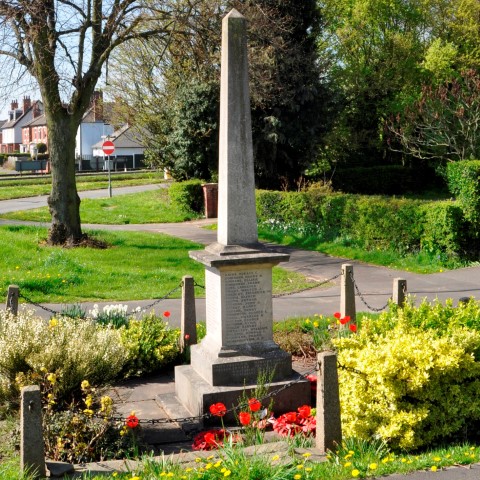All Singing And Dancing – The Dyches of Long Eaton
Recently, ‘Unexamined Lives’ researched the family history of the Borrowash Dyches, working from William Dyche’s handwritten memoir. His vibrant account (overlapping the 19th and 20th centuries) is enhanced by some intricate watercolour paintings of the village and his childhood home, but the ‘Dyche file,’ held by the Derbyshire Records Office, also contains over 100 black and white photographs of other people.
They are young, seemingly affluent and suspended in a 1930s time warp in the full bloom of careless youth; taking their pleasures in a variety of holiday locations as disparate as Skegness, Blackpool, Naples and Gibraltar. Most of the photographs offer little identification other than occasional first names, and our early assumption that the people must be William Dyche’s relatives is undermined by a peek at their clothes. It would be highly unlikely that the dour, unbending, farming Dyche Methodists of Borrowash would disport themselves in beach wear on the deck of a cruise ship and they would be equally unlikely to don formal evening dress or theatrical costume. Would they have the money to embark upon a cruise and might they deem activities like cruising frivolous, when all god-fearing individuals should be on their knees at the Methodist church? Probably! Jabez Dyche, who toiled thanklessly at Derby Gaol, would consider garments to be a functional necessity, but for these other Dyches, things to wear equalled finery, fun and adornment and a cruise meant secular pleasure. Apart from a surname, the Dyches in the album and the Dyches of Borrowash have nothing in common at all.
Keith Oseman, our ‘Unexamined Lives’ resident genealogist was up for a challenge and began with the four fully signed photographs in the album. The individuals appear to be wearing theatrical clothes and their images have been possibly autographed as performance souvenirs, because the language of the inscriptions is too formal to be intended for a friend or family member (‘Yours v. sincerely, Madeleine Dyche’, ‘Yours always, Very Sincerely, A.D’, ‘Faithfully Yours, Agnes Dyche’, ’Yours Very Sincerely, A.H. Dyche’).
Now Keith browsed the Ancestry and FindMyPast genealogy databases and uncovered a wealth of advertisements and newspaper articles, advancing his goal of unmasking Madeleine, Arthur and Agnes. The 1911 Census supplied further detail and revealed only one family with matching names, living at 16 Beaconsfield Street: the Dyches of Long Eaton.
Arthur Dyche, aged 31 and born in Derby in 1888, is described as ‘Head’ of the family and a grocer’s assistant. His wife Agnes, a year older, was born in Long Eaton like the couple’s 8-year-old daughter Madeleine. The baby of the family was two-year-old Frank, and Agnes’s 26-year-old unmarried brother, Edgar Drennan completed the household. According to the form, Agnes and Arthur had been married for nine years and the Marriage Indexes place the marriage in the Shardlow Registration District that included Long Eaton. Scrupulous accuracy in recording information for official purposes in 1911 could not necessarily be guaranteed. Agnes is listed as ‘Agnisa’ in the Marriage Indexes, but becomes Agnes in the Census. Her daughter Madeleine appears as ‘Madoline’ in the Census and the Birth Indexes, referring to her as ‘Madeleine Agnesa Dyche’, state that she was registered in the Ilkeston Registration District in ‘about 1902.’ In a later document (the 1939 Register) her birth date is given as 9th April 1902 and official listing of her brother Frank’s birth varies from 1909 to 1908.
Agnes’ father, Thomas Alexander Drennan came from Ockbrook and established a grocery business in Long Eaton as well as dabbling in the lace trade there. Edgar (who lived with Agnes and Arthur at Beaconsfield Street) is described as a ‘lace draughtsman’ in the 1911 Census, but Agnes’s other brother, named Thomas Alexander after their father, was something of a risk-taker. He had a season as a professional footballer with Coventry City in 1908 – 09, making 16 appearances and scoring one goal but it was to be a short career. Like many retired footballers in the latter half of the 20th century, he became a publican, but in this new trade, failed to thrive and was registered bankrupt in 1925. By contrast, Thomas Drennan senior was thrifty. When he died in 1909, his estate was valued at £9,000 and he was a homeowner, leaving two properties in joint names to Agnes and Thomas. Taken together, the houses were known as ‘The Brickfields’, named after a field near to Manchester Street where at one time bricks were made and now it is possibly the site of Long Eaton’s Manchester Field. However, the houses remained empty, and on 16th May 1913, they hit the local headlines.
‘The Nottingham Evening Post’ sub-editor went for sensationalism:
‘LARCENY OF LEAD
RAID ON EMPTY HOUSES AT LONG EATON’
The booty stolen from the houses turns out to be:
‘lead and taps ……cut away from the wall over the sinks in the kitchens’ by John Foster and Benjamin Davis when ‘in drink’. A neighbour, William Robinson noticed ‘a quantity of lead piping with two brass taps attached to it in his yard’ and informed the police. When interrogated by PC Kendall, the two intrepid burglars each accused the other of ripping the piping off the walls and the incident has the flavour of a drunken prank. In court, Davis must have told the most convincing story because he was discharged, but Foster was convicted and fined 40 shillings including costs with the alternative penalty of a month’s hard labour. We don’t know what he chose!
The Long Eaton Dyches became newspaper ‘regulars’ for another reason; Arthur and his daughter Madeleine had a penchant for the stage. There is no mention of Agnes treading the boards, but her signed photograph depicts a stylish woman, arrayed in a beaded evening dress, white elbow-length gloves, her coiffure embellished by a hair ornament; not an ensemble in which to clean the kitchen! The family could have enjoyed attending first night theatre productions, or Agnes might have been attending a performance featuring her husband or daughter. ‘The Derby Daily Telegraph’ filled a column in its 1912 9th May edition by detailing an ‘entertainment’ at the Congregational Chapel in Crewton, Derby.
The local impresario is ‘Madame Lala Williams’ and she heads a troupe’ called the ‘Merry Little Gipsy Maids’. The programme, considered to be ‘of very nice length’, was so favourably received that the lay pastor. Mr John Knowles ‘proposed a hearty vote of thanks to the artistes’ and the entire programme was repeated in the same place a few days later. This was the era of musical hall variety acts and the Merry Little Gipsy Maids were followed by a child pianist, a tambourinist and ‘coon songs and dances’ an early 20th century populist version of The Black and White Minstrel Show, also referenced in a derogatory fashion in ‘Sons and Lovers’, the novel published in 1913 and written by Nottinghamshire novelist, D. H. Lawrence.
Also billed as performers were ‘three pierrots, Arthur Dyche, Reggie Dunn and Sidney Bull.’ Pierrots were traditional pantomime characters; lovelorn buffoons or clowns stemming from a 17th century troupe of Italian players performing in Paris and known as the Commedie-Italienne. The signed photograph of Arthur Dyche does not depict him in the traditional pierrot pantaloons and black skull cap; he appears in another guise (and no doubt another role) dressed in 18th century costume, complete with wig and in a bizarre touch, his feet are shod with roller skates!
The performers at Crewton were clearly a settled amateur variety company because on 27th January, 1927, ‘The Derby Daily Telegraph’ reports on the appearance of the same acts at the Alvaston Brotherhood, although this time, Arthur is showcasing his singing:
‘The Misses Cecile and Hilda Banks (monologue) and Mr Arthur Dyche (baritone), together with selected chorus completed a very attractive programme.’
Arthur’s daughter Madeleine inherited her father’s ear for music and took those skills to a new level. She appears frequently throughout the 1920s, at venues in Nottingham and these are rather grander than Arthur’s chilly church halls. On 16th February, ‘The Nottingham Evening Post’ heralds her presence at the Scala Theatre, Market Street as:
‘Miss Madeleine Dyche, the favourite mezzo-soprano.’ Her notices are uniformly favourable; she is ‘popular’, a favourite’ and on 20th March, 1924, ‘The Nottingham Evening Post’ can scarcely suppress its excitement. Billed to appear at The Scala yet again, Madeleine is described as:
‘Miss Madeleine Dyche, the brilliant mezzo-soprano.’
Her signed photograph shows a young lady wearing a traditional, twenties ‘flapper-style’ dress; the ankle-length Edwardian costume has been superseded by a loose short crochet-sleeved frock with a hemline just below the knee. Madeleine’s hair is bobbed; she is rather chubby and is pert and pretty rather than beautiful; Long Eaton’s 1920s pocket-sized version of Sheridan Smith. The multiple engagements indicate that she was at least a semi-professional singer and in July 1924, she is listed in the Theatrical Cards section of ‘The Stage’, still the prime newspaper of the theatrical industry. This time she is delighting audiences in Ilkeston:
‘VOCALISTS: Miss Madeleine Dyche, Mezzo-Soprano – This week King’s Picture House, Ilkeston.’
On 22nd October, 1927, ‘The Nottingham Post’ gives notice of Madeleine’s forthcoming engagement at the Empress Cinema as a soloist with a military band. She has extended her range and is this time singing as a soprano:
‘St John’s Ambulance Brigade Military Band (Conductor, Supt J.W. Elliot). Vocalists: Miss Madeleine Dyche, soprano; Mr J.H. Taylor, tenor.’
The Empress Cinema was an imposing venue. Converted from a skating rink that burned down in 1910, the cinema opened its doors in 1913. It had an audience capacity of 1,200 but closed in 1927 to be replaced by the open market that had moved from the market place, which in turn made way for the new Slab Square. In 1928, it returned to its origins and was replaced by the New Empress Cinema.
Madeleine’s ‘career’ soared to new heights in 1927 when she branched out into radio with her own programme on the radio station ‘Nottingham 5NG.’ It was a brief interlude from 5.-5.15pm and again listed in the faithful ‘Nottingham Evening Post’ on 17th November, 1927:
Madeleine Dyche (mezzo soprano).’
On 9th November, 1928, the paper bills her in a variety show programme at The Picture House in Long Row:
‘Madeleine Dyche, the Popular Mezzo-Soprano’
And then she disappears from the papers entirely until 24th April, 1937 when, at the age of 35, she triumphs in the local heat of the ‘Silver Voice Girl’ organised by the Gaumont competition at the Nottingham Hippodrome. According to ‘The Nottingham Evening Post’, she has come first and is now living at Gladstone Road in Long Eaton. This seems to have been something of a last hurrah for Madeleine. The eventual winner was Miss Irene Mansell and we do not hear of Madeleine in this capacity again.
Madeline made her long-term home in Long Eaton and in the 1939 Register is cited as a resident on 3 Abbott Street. Her occupation is listed as a ‘Gown Sales Woman’ and also living there were her mother, Agnes (‘Unpaid House Domestic Duties) and her brother, Frank (Ladies’ Hairdresser). Her Record in the National Probate Register shows that Madeleine died on 27th August, 1980, aged 78. 3, Abbott Street was still her home; she had never married and she left a very substantial will of £37,000. By this time it appears that she was the last surviving member of the Long Eaton Dyches because a reference appeared in the London Gazette, asking for missing beneficiaries to come forward. We don’t know if there were any – or if they did.
Why did Madeleine suddenly stop singing? She certainly pushed what talent she had to the limit and perhaps when she failed to win the ‘Silver Voice Girl’ competition she realised that she had reached her limit. Did she decide that winning local heats in prestigious competitions was not for her when she had aimed for the stars and that she would rather give up all together than remain firmly in the second division of mezzo sopranos? Or was there another reason?
In the early years of the 20th century, any type of theatrical performance for women was still regarded in some circles as morally dubious. This would have been the case in sophisticated cities like London; how much more would eyebrows have been raised in places like Nottinghamshire and Derbyshire at the idea of ‘Arthur Dyche’s girl’ hawking herself round the stage of every cinema in the district? Singing was traditionally regarded as a graceful accomplishment for a young lady – on display at entertainments in the home rather than in the public arena.
Yet there is something of the feminist pioneer about Madeleine who set her sights on the stage, did not feel the need to marry, had an eye for fashion with a career in a dress shop and left a very healthy sum of money in her will. She had inherited her penchant for the bright lights from her parents, the Long Eaton Dyches, took their enthusiasm to a higher level and it is a shame that she did not have children herself because who knows what they would have done and whom they would have become?






One Response to All Singing And Dancing – The Dyches of Long Eaton